|
 |
 |
Payrolls
suggest slowdown, again
Econoday Simply
Economics 7/7/00
By Evelina M. Tainer, Chief Economist |
Stocks
rally on job news
The third quarter began on an upbeat note.
Stock prices were generally higher this week despite warnings about
potentially weaker second quarter earnings from some large companies.
All market indices benefited from the employment report, which ended
up somewhat weaker than expected. It confirmed the tone set a month
ago when the employment situation for May showed a drop in private payrolls.
The June rebound was modest and sets the second and third quarters on
a slower growth track. As a result, stock market investors are feeling
more confident that the end of the Fed's tightening for this cycle may
be near.
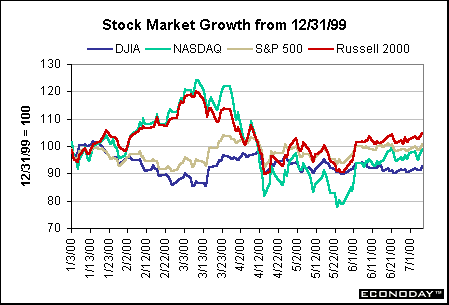
The Russell 2000 continues to outperform
other major indices relative to year-end 1999, with a gain of 4.7 percent. Some
analysts were concerned that the Russell's gains might not continue with the
reshuffling of the 2000 deck. Each year at the beginning of July, the Russell
2000 gets a face lift as fast growing companies which are no longer considered
"small-cap" are removed and pushed into the Russell 1000. At the same
time, new "small-cap" companies become part of the 2000 family. Many
of the faster growing companies that were removed from the Russell 2000 this
year were in the technology sector. At least a good number of the new entries
were more "main-line" economy. It will be interesting to follow the
progress of this updated index.
The S&P 500 is just over the 100 mark - meaning that it is on par with year-end 1999 levels. The NASDAQ composite index is nearly there. Only the Dow Jones Industrials are lagging significantly behind, 7.5 percent below December 31, 1999 levels.
Bonds rally on
soft jobs report
The employment situation didn't disappoint
bond investors this week. Payroll gains were less than expected - even
after taking into account a drop in temporary Census workers which depressed
gains. Treasury securities rallied across the curve - with larger price
gains (and sharper yield declines) at the shorter end, such as the 2-year
note. Economic news had been favorable earlier in the week, but strong
factory order headline numbers on Thursday made bond investors skittish,
particularly in advance of the jobs data. The favorable employment report
could set a friendly tone for the bond market in the coming week as
market players set up for two key indicators -- retail sales and producer
prices. A soggy retail sales report will further add to the ebullience
among bond investors as they know Fed officials are looking for a moderation
in consumer demand.
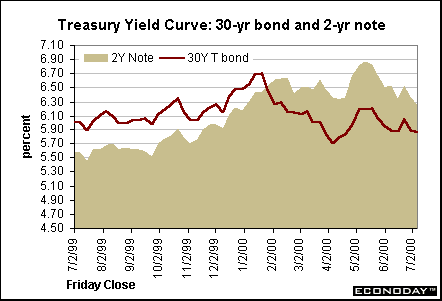
| Markets
at a Glance |
| Treasury
Securities |
12/31/99
|
June
30
|
July
7
|
Weekly
Change
|
| 30-year Bond
|
6.48%
|
5.89%
|
5.86%
|
- 3 BP
|
| 10-year Note |
6.43%
|
6.02%
|
6.00%
|
- 2 BP
|
| 5-year Note |
6.34%
|
6.17%
|
6.09%
|
- 8 BP
|
| 2-year Note |
6.24%
|
6.36%
|
6.27%
|
-
9 BP
|
| |
|
|
|
|
| Stock
Prices |
|
|
|
|
| DJIA |
11497*
|
10448*
|
10637*
|
+ 1.8 %
|
| S&P 500
|
1469*
|
1455*
|
1479*
|
+ 1.6 %
|
| NASDAQ Composite
|
4069*
|
3967*
|
4023*
|
+ 1.4 %
|
| Russell 2000
|
505*
|
517*
|
528*
|
+ 2.1 %
|
| |
|
|
|
|
| Exchange
Rates |
|
|
|
|
| Euro/$ |
1.0008
|
0.9531
|
0.9476
|
- 0.6 %
|
| Yen/$
|
102.40
|
106.23
|
107.83
|
+ 1.5 %
|
| |
|
|
|
|
| Commodity
Prices |
|
|
|
|
| Crude Oil ($/barrel) |
$25.60
|
$32.40
|
$30.38
|
- 6.2 %
|
| Gold ($/ounce)
|
$289.60
|
$291.60
|
$284.70
|
- 2.4 %
|
| |
|
|
|
|
| (BP = basis points; stock
price indices are rounded) |
Jobs report
shows signs of moderation
Nonfarm payroll employment edged up a meager
11,000 in June after a downward revised gain of 171,000 in May. Temporary
Census workers once again obscured underlying trends. Between January
and May, 603,000 Census workers bloated payrolls. In June, 190,000 Census
workers came off the payrolls and depressed the data. The chart below
depicts the monthly changes in nonfarm payroll employment compared with
its moving average (with and without Census workers). Note the red portion
of the moving average line is weaker and represents the three-month
average of the nonfarm payrolls excluding Census workers. But with or
without temporary government workers, the trend is decidedly lower over
the past several months. This should encourage Fed officials who are
concerned about the overheated economy. The negative impact of the past
six rate hikes is finally starting to be reflected in the monthly economic
data.
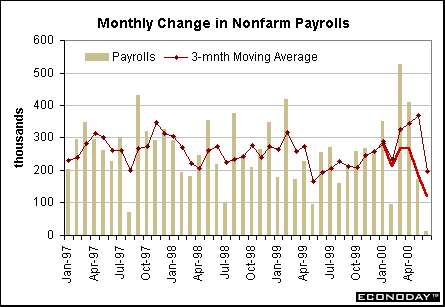
The civilian unemployment rate
edged back down to 4 percent, but is still just above the cycle low of 3.9 percent
last seen in April. Both labor force and employment rose during the month, but
only about one-third as much as these series declined last month. Perhaps more
disconcerting for Greenspan & Company is the 349,000 decline in the pool
of available workers. The monthly series (which goes back to 1994) now stands
at its all-time low. The quarterly series stands at its lowest level since the
third quarter of 1974. Greenspan's concern over the diminishing labor pool is
not unfounded.
Yet, wages don't appear to be accelerating.
Average hourly earnings rose 0.4 percent in June, more than the 0.1 percent
gain posted last month but in line with gains of the past several months. The
monthly gain kept the year-over-year rise at 3.6 percent. Yearly wage gains
have remained relatively stable for the past 18 months.
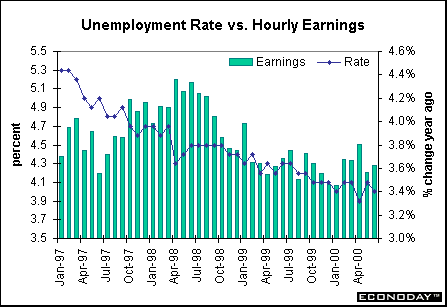
The bottom-line on the employment situation? No doubt about it, employment growth moderated in the second quarter. The chart below compares total hours worked in the nonfarm economy relative to GDP growth. Hours worked moderated significantly in the second quarter and this confirms economists' forecasts that real GDP growth is likely to come in much softer than the first quarter's blistering 5.5 percent rate. Most forecasts are currently centering on a 3.5 percent pace for the second quarter, below the 4 percent speed limit indicated by Fed officials. Yet the question isn't so much about the pace of the second quarter, but its sustainability. Will conditions rebound in the second half of the year should the Fed tighten the screws some more this summer? The June employment report may have stock and bond market players starting to hope that the Fed's tightening cycle is complete.
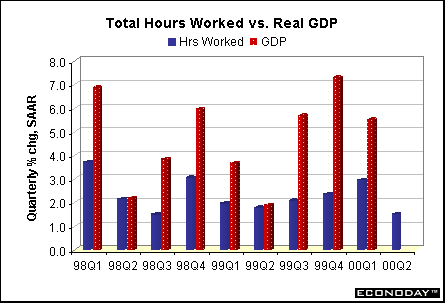
Manufacturing headline overstates growth
Factory orders rose 4.1 percent in May, more than reversing April's 3.8 percent drop. While a variety of the components flip-flopped in April and May, the bulk of the May rise came from a 26.4 percent spurt in electronic and other electrical equipment - which had plunged 17.6 percent in April. Engines and turbines, a subcomponent of industrial machinery, staged a similar reversal - rising 26.5 percent in May after dropping 20.6 percent in April. The larger-than-usual variability in monthly changes underscores the bulkiness of factory orders, but also could indicate a problem with seasonal adjustment.
The headline figures momentarily
stunned market players, but the fact remains that new orders are not accelerating.
The chart below depicts quarterly growth rates (at annual rates) over the past
eight quarters. Notice how sluggish data was in April and May relative to the
first quarter! The employment data does point to a modest increase in industrial
production in June, confirming the slowdown in new orders.
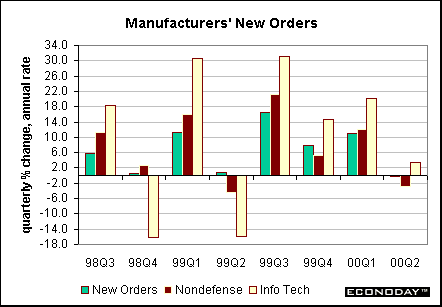
Consumers feeling pinch of higher gas prices?
Motor vehicle sales are considered somewhat of a leading indicator of consumer spending since interest rate changes tend to affect this big-ticket item. A rising interest rate environment typically has a negative impact on car and truck sales unless automakers offset rising market rates with their own incentives. Incentives were offered by a variety of automakers the past couple of months, but these incentives likely affect market share more than total car demand. The chart below shows a clear downward trend in light truck sales. Anecdotal evidence has not indicated that the drop in sports utility vehicles was due to rising gasoline prices, but peak sales correspond to the oil price spurt. The fact that car sales didn't take up the slack does suggest that total motor vehicle demand could be downshifting, a result of higher borrowing costs as interest rates have risen in the past year.

Retailers reported soggy chain store sales in June. These confirmed the weekly reports by the BTM chain store sales index as well as the LJR Redbook. When gasoline prices first began to rise last year, price increases were modest and could be shrugged off by consumers enjoying healthy income growth. In the past couple of months, pump prices jumped sharply and many car and truck owners were facing significantly higher gasoline bills. These couldn't be ignored. This likely cut into expenditures for discretionary spending on eating out or clothing.
THE BOTTOM LINE
Fed officials look like heroes after the employment report. It was certainly a good thing they didn't raise rates at the late June meeting. It would have made it even more unpleasant for Fed Chairman Alan Greenspan when he faces the firing squad - oops, the Senate Banking Committee - for the monetary policy update in mid-July (in lieu of the expired Humphrey-Hawkins testimony). And the June employment report confirmed that the May drop in private payrolls, which excludes Census workers, was not necessarily a fluke.
Fed officials are not just concerned with the employment situation, but also evidence that consumer demand is waning. Indeed, auto and truck sales continued their moderation in June and chain store sales were anemic during the month. Perhaps the weather didn't quite cooperate in June, but there is no question that higher energy prices had to put a crimp on discretionary spending as well.
So what does this mean for future Fed policy? If inflation figures don't worsen and consumer spending moderates sufficiently, the Fed might be able to leave policy unchanged at the August FOMC meeting just as they did at the June meeting. Many economists might not be convinced that second quarter moderation will be sustained and could therefore still be predicting more Federal Reserve rate hikes in the future. But market players might be more bullish.
Looking Ahead:
Week of July 10 to July 14
Market News International compiles this market consensus which surveys about 20 economists each week.
Monday
The consensus shows that consumer installment credit is expected to expand $8 billion in May after a $9.3 billion gain in April. Increases appear progressively smaller by the month since the beginning of the year, but still represent heavy borrowing by consumers. The forecasts range from a low of $2 billion to a high of 10.4 billion.
Thursday
Market participants are expecting new jobless claims to increase 9,000 in the week ended July 8 from last week's 296,000 level. Claims are likely to be rather volatile in the next several weeks since summer factory shutdown schedules are not exact from year to year. The forecasts range from a level of 300,000 to 321,000.
Import prices are expected to increase 0.7 percent in June, just slightly less than the 0.6 percent gain posted in May. This still points to gains coming from higher energy prices. Export prices are predicted to remain unchanged for the month after dipping 0.2 percent in the previous month. Very few economists are predicting these figures, so the consensus is formed from a small sample and must be interpreted with more caution than usual.
Friday
Market participants are expecting the producer price index to jump 0.6 percent in June after remaining unchanged in May. Energy prices were surprisingly weak last month and a catch-up is likely. Excluding food and energy prices, the PPI is expected to inch up 0.1 percent. This would be better than last month's showing of a 0.2 percent gain. The forecasts for the total PPI range from a low of +0.4 percent to a high of +1.1 percent. The forecasts for the core PPI range from unchanged to +0.2 percent.
Economists are predicting retail sales will increase 0.4 percent in June, reversing some of the declines of the previous two months. Excluding autos, retail sales should also rise 0.4 percent. This partly reflects higher gasoline prices - which boost gasoline sales in dollar terms. The weekly chain store sales figures were on the anemic side for the month, though, suggesting that higher pump prices are putting a crimp on consumer spending. The forecasts range from +0.1 to +0.6 percent on total retail sales; and range from +0.2 percent to +0.7 percent on nonauto retail sales.
The market consensus is looking for a 0.3 percent hike in industrial production, based on the hours worked and factory payroll figures. Last month production rose 0.4 percent. The forecasts range from a low of unchanged to a high +0.6 percent. The capacity utilization rate should edge up to 82.2 percent in June from 82.1 percent in May. The forecasts range from 81.9 to 82.4 percent.
Looking
ahead to the week of July 17
Early estimates show a consensus forecast of 0.5 percent for the consumer price index. This incorporates a boost in energy prices. Excluding energy, the CPI should post a gain of 0.2 percent, in line with the past several months. The forecasts range from +0.4 percent to +0.7 percent on the total CPI; +0.2 percent to +0.4 percent on the core CPI.
|